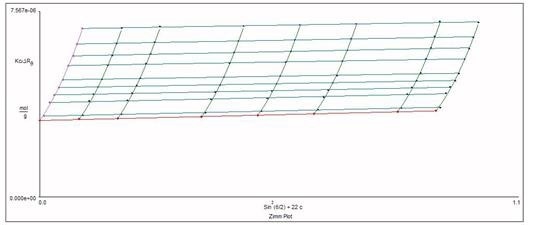Characterization of dilute polymer solutions using static light scattering (SLS) is now easier and more accurate with better value. The BI-MwA uses a 30 mW, 660 nm diode laser and seven angles to establish the intensity of scattered light as a function of angle and polymer concentration. Based on this information, one of the three plots is developed with the basic BI-MwAZP software: Berry, Zimm, or Debye.
From such plots, calculation of the root-mean-square radius (radius of gyration), Rg, the weight average molecular weight, Mw, and the second viral coefficient, A2, can be done. The BI-MwA can be used in flow or batch mode, as a chromatography detector, or for following the kinetics of polymerization using time-dependent static light scattering (TDSLS). Overall, the BI-MwA ideally has the maximum performance/price ratio of any light scattering detector employed for Mw determination.
- Proteins
- Mw of polymers
- Natural and synthetic
- Study aggregation
Why Seven Angles?
A single, low angle is adequate, theoretically, to establish Mw. But, calibration is still needed without dust or flare light interfering. This necessitates an extra 90° measurement. A minimum two angles are needed to establish Rg from a straight line fit. However, two points always establish a straight line, without any room for error. Thus, three angles are the absolute minimum for a least squares fit. What if dust alters one of the angular intensity values? What if more accuracy is needed? For these reasons, the basic BI-MwA optical configuration comprises of seven angles. Other configurations can be availed upon request.

Figure 1. Static Light Scattering: Zimm Plot for Mw
Rugged Design, Small Footprint
About a polymer handbook size, the BI-MwA design avoids the drawbacks of similar machines. The flow path is vertical, not horizontal, shunning trapped bubbles. There are no sharp corners within the cell, just conical shapes. Earlier solutions are more effortlessly flushed. The cell can endure much greater pressures than previous instruments of this type, up to 3.5 MPa, reducing the chance of a costly repair.
Unique Microcontroller and Detector Design
The exclusive microcontroller used in the BI-MwA supports four analog inputs as basic, 16 optional, all having 24-bit resolution. Two-way communication is achievable using a USB port. The BI-MwA is fully re-programmable via flash memory. In this manner, as necessities vary, so does the instrument with least bit of effort. The ultra-sensitive CCD detector is consistent in its response, and, together with the microcontroller, permits automatic gain adjustment across many decades of scattered intensity. The cell can endure much greater pressures than previous instruments of this type, up to 3.5 MPa, reducing the chance of a costly repair.
Applications
The BI-MwA is suitable for exploring natural and synthetic polymers in solution, including polysaccharides and proteins. It allows examination of oligomerization, stability, aggregation, complex formation, and conformation. SLS is an absolute method for Mw determination; while, viscosity measurements need calibration and too many assumptions about the polymer/solvent system that may not be correct in a specific case. Even shape may be established in certain cases by plotting log Mw vs log Rg. The slope of the line can show whether the molecule is coiled, rod-like, or spherical.
Specifications*
| Cell & Optics |
| Angles |
7, nominally 35, 50, 75, 90, 105, 130, and 145, plus a reference angle |
| Fiber |
Low numerical aperture, integral to cell |
| Back Pressure |
3.5 MPa (500 psi) maximum |
| Fittings |
Standard HPLC inlet/outlet panel |
| Volume |
Cell, 100 µL nominal; scattering, 20 nL nominal |
| Laser |
Nominal 30 mW, 637 nm, vertically polarized |
| Cell |
PEEK standard, options by request |
| Electronics & Detector |
| Control |
Integrated, dedicated, powerful microcontroller |
| Detector |
CCD, ultra-high sensitivity and spatial uniformity |
| Inputs |
4 standardswith 16 to 24 bit resolution, 15 optional with 24 bit resolution; computer selectable gain; suitable for use with most common RI, UV, and viscometer, thermocouple, thermistor, injector, pressure gauge, and pump outputs |
| Power Requirements |
100/115/220/240 VAC, 50/60 Hz 25 watts |
| Dimensions |
195 x 210 x 380 HWD in mm |
| Weight |
5.5 kg |
| Options |
BI-TDLS Software for monitoring polymerization kinetics |
*A policy of continual improvement may lead to specification changes.